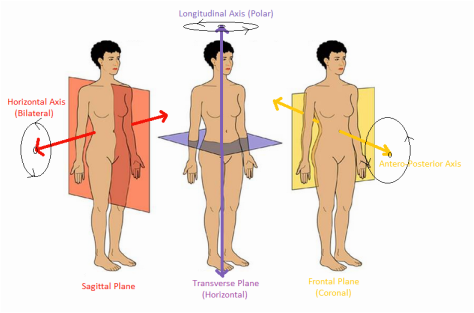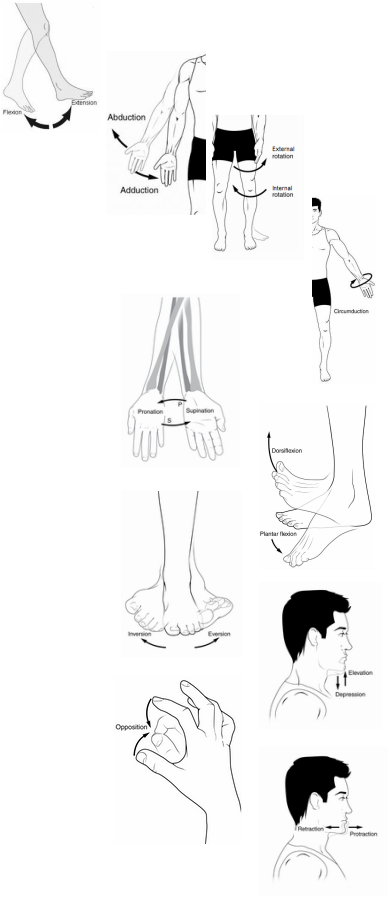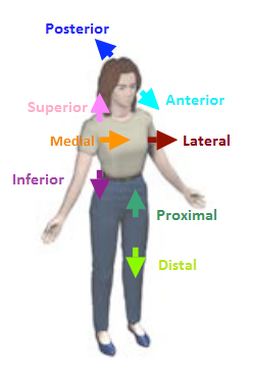ANATOMICAL TERMS

Anatomical Planes
Relate to planes through the human body at right angles to one another. There are 3 planes:
Anatomical Axes
Describes the direction of movement at joints. There are 3 axes:
Relate to planes through the human body at right angles to one another. There are 3 planes:
- sagittal plane: divides body into left and right (medial/lateral)
- transverse (horizontal) plane: divides body into top and bottom (superior/inferior)
- frontal (coronal) plane: divides body into front and back (anterior/posterior)
Anatomical Axes
Describes the direction of movement at joints. There are 3 axes:
- horizontal/bilateral axis: runs east and west
- longitudinal/polar axis: runs north and south
- antero-posterior axis: runs front and back
Relationship Between Anatomical Planes and Axes
- axis of rotation is always perpendicular to plane of movement
- simple movements can be described in terms of their plane of motion and axis of rotation
|
Describing Position and Movement
Anterior: towards the front of the body Posterior: towards the back of the body Superior: closer to the head of the body Inferior: closer to the foot end of the body Medial: towards the midline of the body Lateral: away from the midline of the body Proximal: nearer the point of attachment (of a limb to a trunk) Distal: farther the point of attachment (of a limb to a trunk) Plantar: on or towards the sole of the foot Dorsum: on uppermost surface of the foot Superficial: on or near the surface Deep: farther away from the surface |

Basic Movements
Flexion: decreasing the angle of a joint (bending)
Extension: increasing the angle of a joing (straightening)
Abduction: movement away from the midline of the body
Adduction: movement towards the midline of the body
Internal Rotation: front (anterior) surface of a limb turns inward (medially)
External Rotation: front (anterior) surface of a limb turns outwards (laterally)
Circumduction: circular motion; combines flexion, extension, abduction, adduction
Supination: rotation of forearm and hands to palms up position
Pronation: rotation of forearm and hands to palms down position
Plantar flexion: increases angle between foot and lower leg (pointing toes)
Dorsiflexion: decreases angle between foot and lower leg
Inversion: standing on the outer edge of the foot
Eversion: standing on the inner edge of the foot
Elevation: raising up to a more superior position
Depression: pulling down to a more inferior position
Opposition: moving the thumb to touch anyone of the other fingers
Reposition: thumb is returned to anatomical position
Protraction: moving in a foreward (anterior) direction
Retration: moving in a backward (posterior) direction
Flexion: decreasing the angle of a joint (bending)
Extension: increasing the angle of a joing (straightening)
Abduction: movement away from the midline of the body
Adduction: movement towards the midline of the body
Internal Rotation: front (anterior) surface of a limb turns inward (medially)
External Rotation: front (anterior) surface of a limb turns outwards (laterally)
Circumduction: circular motion; combines flexion, extension, abduction, adduction
Supination: rotation of forearm and hands to palms up position
Pronation: rotation of forearm and hands to palms down position
Plantar flexion: increases angle between foot and lower leg (pointing toes)
Dorsiflexion: decreases angle between foot and lower leg
Inversion: standing on the outer edge of the foot
Eversion: standing on the inner edge of the foot
Elevation: raising up to a more superior position
Depression: pulling down to a more inferior position
Opposition: moving the thumb to touch anyone of the other fingers
Reposition: thumb is returned to anatomical position
Protraction: moving in a foreward (anterior) direction
Retration: moving in a backward (posterior) direction



